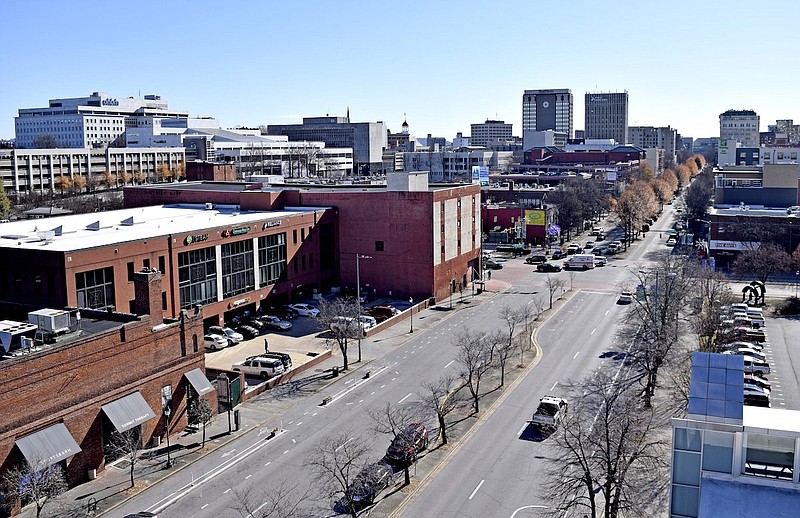If-you-build-it, they-will-come worked 30 years ago with the Tennessee Aquarium. But will wide medians, more trees and narrowed streets turn the same trick for Broad Street in downtown Chattanooga?
Officials from Florida-based design firm Dover, Kohl & Partners and River City Co., which is overseeing the work, hope they will. Because the design firm's plan notes that 60% of Broad between Aquarium Way and Fourth Street is characterized by "nonactive frontage," which includes "nearly full city blocks of blank facades and surface parking lots."
In other words, not much is going on in an area which should be able to entice a tourist or even a city resident to come in from the suburbs and take in what all the area has to offer instead of, say, visiting the Aquarium and then leaving.
The plan, which grew out of the recent One Riverfront plan and which reimagines the seven blocks from the Tennessee Aquarium to M.L. King Boulevard, offers three designs, each of which narrows Broad Street from four lanes to two, enhances the little used bike lanes, adds more trees and makes the sidewalks on one or both sides of the street large enough to accommodate outdoor dining.
What the planners are up against is that 2023's downtown is not the lively, trendy place it became after the aquarium opened its doors in 1992 and former Mayor Bob Corker's riverfront makeover was completed nearly 20 years ago. It is a place considerably hollowed out by the recent COVID-19 pandemic and resulting trend to remote work.
With the worst of the pandemic over, many employers saw that their workers could be just as efficient working from home, the companies could save money and so they did not force them to return.
The TVA Complex, for instance, which opened in 1985 to serve 3,000 employees, had only several hundred workers last year and eventually will have none. Its space has been mentioned as a possible location for a new federal courthouse.
The BlueCross BlueShield office complex on Cameron Hill was completed in 2009 to house about 4,000 employees for the state's largest health insurer, but Roy Vaughn, the insurer's chief human resources officer, said earlier this month that about 88% of the organization's staff is working from home.
Those two employers, alone, account for up to 7,000 workers, most of whom no longer work downtown. When they don't work downtown, they don't have breakfast, lunch, dinner or coffee downtown, they don't shop downtown on their lunch hours, and they don't stay after work for a drink, dinner or entertainment.
As such, restaurants, small businesses and entertainment venues have fewer customers and may not be able to make it on the tourist trade that slows in the winter.
Which brings us back to Broad Street.
Each of the design renderings looks inviting and depicts a tree-lined Broad Street teeming with outdoor cafes and people, with the bicycle lanes in use and with just a few cars using the narrowed street.
Indeed, one of the planners invites observers to compare what could be created on Broad Street to The Ramblas, a boulevard in Barcelona, Spain. However, a visit to the Dover, Kohl & Partners website indicates their designs for Chattanooga look equally similar to ones they created for Johnson City, Tenn., Lansing, Mich., or Arlington, Va.
But renderings are not real life.
In reality, slow buses could create lines of traffic on single lanes, deliveries could be problematic (though designers swear there still will be access), and outdoor cafes may never materialize because of the fear there won't be enough patrons nor enough employees to serve the patrons they might have.
The cost of the three designs will be revealed at another time, officials said. Funding could come from local, state, federal or private sources. The cost of the planning effort was provided by the Lyndhurst Foundation, Benwood Foundation, the city and River City Co. No mention was given of the city's portion.
We like the park-like look of the designs and long for a downtown that had the energy it did between the completion of the 21st Century Waterfront and the Great Recession and between the recovery from the Great Recession and the pandemic. We are leery, though, that a Broad Street makeover alone can be the catalyst for such energy.
However, if some of that 60% of "nonactive frontage" between Aquarium Way and Fourth Street can become active and some of the more active area between Fourth and Sixth streets can move gradually toward the Aquarium, a more lively corridor could ensue.
But that's a big "if." And with no costs currently associated with the project, and no influx of people returning to the area anytime soon, questions remain.
On the other hand, the Tennessee Aquarium once was only a big "if," too.
GET INVOLVED
Designers and local officials want the public to help choose which Broad Street makeover design they prefer at broadstreetcha.com.
